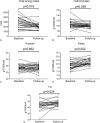Nonalcoholic fatty liver disease is associated with excessive calorie intake rather than a distinctive dietary pattern
- PMID: 27281105
- PMCID: PMC4907683
- DOI: 10.1097/MD.0000000000003887
Nonalcoholic fatty liver disease is associated with excessive calorie intake rather than a distinctive dietary pattern
Erratum in
-
Erratum: Medicine, Volume 95, Issue 23: Erratum.Medicine (Baltimore). 2016 Jul 18;95(28):e0916. doi: 10.1097/01.md.0000489580.04709.16. eCollection 2016 Jul. Medicine (Baltimore). 2016. PMID: 31265603 Free PMC article.
Abstract
We aimed to assess the dietary patterns associated with nonalcoholic fatty liver disease (NAFLD) and the efficacy of dietary interventions in a real-life setting at a tertiary medical center in Northern Germany.Clinical and laboratory data as well as data obtained by a semiquantitative food frequency questionnaire of 55 consecutive patients diagnosed with NAFLD were compared to an age and gender-matched cohort of 88 healthy individuals by univariate analysis. The efficacy of the dietary intervention was assessed in a subgroup of 24 NAFLD patients 6 months after receiving dietary advice. Macronutritional components of the diet were normalized for absolute daily energy intake.NAFLD patients consumed more calories per day as compared with healthy controls (P <0.001). The absolute amounts of most nutritional components ingested by NAFLD patients were higher than those of the controls. However, there were no significant differences with regards to the relative consumption of carbohydrates (P = 0.359), fat (P = 0.416), and fructose (P = 0.353) per 1000 kcal energy intake. NAFLD patients displayed a higher intake of glucose/1000 kcal (P = 0.041) and protein/1000 kcal (P = 0.009) but a lower intake of fibers/1000 kcal (P < 0.001) and mineral nutrients/1000 kcal (P = 0.001) than healthy controls. In the longitudinal analysis patients significantly reduced their caloric intake and their ALT levels improved 6 months after the dietary counselling (P < 0.001).Our data from a German real-life cohort demonstrate that dietary patterns of patients with NAFLD display great variability and little disease specificity, while the most distinctive feature compared with healthy controls was higher energy intake in NAFLD patients.
Conflict of interest statement
The authors have no conflicts of interest to disclose.
Figures




References
-
- Marchesini G, Marzocchi R, Agostini F, et al. Nonalcoholic fatty liver disease and the metabolic syndrome. Curr Opin Lipidol 2005; 16:421–427. - PubMed
-
- Chalasani N, Younossi Z, Lavine JE, et al. The diagnosis and management of non-alcoholic fatty liver disease: practice guideline by the American Association for the Study of Liver Diseases, American College of Gastroenterology, and the American Gastroenterological Association. Am J Gastroenterol 2012; 107:811–826. - PubMed
-
- Masarone M, Federico A, Abenavoli L, et al. Non alcoholic fatty liver: epidemiology and natural history. Rev Recent Clin Trials 2014; 9:126–133. - PubMed
-
- Vernon G, Baranova A, Younossi ZM. Systematic review: the epidemiology and natural history of non-alcoholic fatty liver disease and non-alcoholic steatohepatitis in adults. Aliment Pharmacol Ther 2011; 34:274–285. - PubMed
-
- Marrero JA, Fontana RJ, Su GL, et al. NAFLD may be a common underlying liver disease in patients with hepatocellular carcinoma in the United States. Hepatology 2002; 36:1349–1354. - PubMed
Publication types
MeSH terms
LinkOut - more resources
Full Text Sources
Other Literature Sources
Medical

